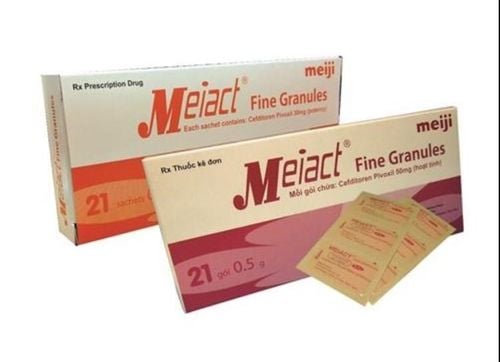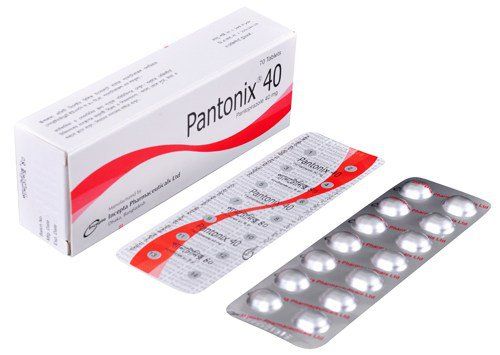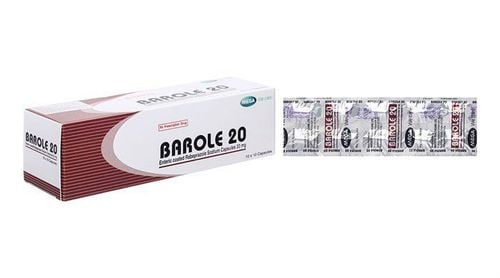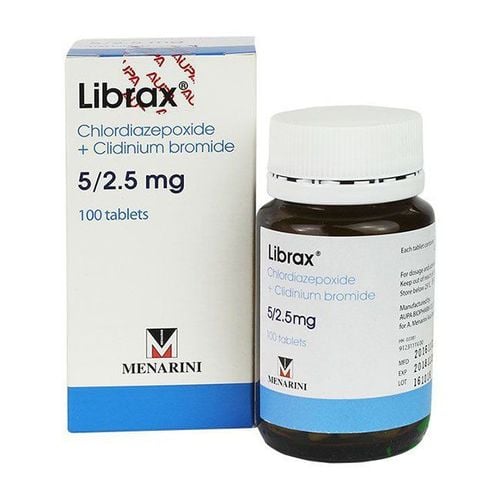If you or your relatives often experience digestive issues, you are likely familiar with Alumina medication. However, there is a lot of information available on the market about Alumina products. This article will help answer your questions: What is Alumina? What diseases does Alumina treat, and what should you be aware of when using it?
1. What medicine is Alumina and what disease does it treat?
Alumina medication is commonly recommended to reduce muscle spasms in patients with peptic ulcer disease (PUD), or excessive stomach acid. In addition, Alumina has other effects that may be prescribed by specialists such as doctors and pharmacists. If patients want to learn more about the specific effects of Alumina, they should consult healthcare professionals for detailed information.
Specific effects of Alumina:
• Alumina helps alleviate symptoms caused by increased stomach acid, such as heartburn, acid reflux, bloating, and indigestion due to excess acid.
• It is used for treating acid reflux associated with peptic and duodenal ulcers.
• Alumina is used in the prevention and treatment of gastric and duodenal ulcers and bleeding caused by stress.
• It is also prescribed for gastroesophageal reflux disease (GERD).
• Alumina is recommended for patients with elevated blood phosphate levels when combined with a low-phosphate diet.
However, in patients with kidney failure, using aluminum-containing antacids to bind phosphate (for phosphate removal) may lead to aluminum toxicity.
Alumina contains the following active ingredients: Aluminum hydroxide, Calcium carbonate, Magnesium carbonate, Atropine sulfate. These ingredients belong to the class of antacids, which help in the treatment of peptic ulcers, duodenal ulcers, and symptoms caused by excessive stomach acid.
The body absorbs Alumina rapidly and completely through the digestive system.
Elimination: 2 paths
- Via feces: Al³⁺, Mg²⁺, and Ca²⁺ are excreted.
- Via kidneys: Al³⁺, Mg²⁺, and Ca²⁺ are excreted through the urine.
Atropine sulfate is primarily excreted via the kidneys.
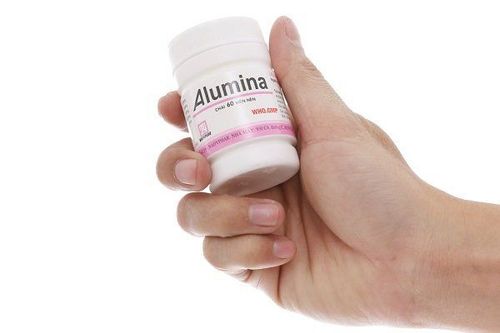
2. Mechanism of action of Alumina
2.1. Pharmacokinetics
The aluminum hydroxide component of Alumina dissolves slowly in the stomach and reacts with gastric hydrochloric acid to form aluminum chloride and water. In individuals with normal kidney function, approximately 17-30% of the aluminum chloride formed is absorbed and rapidly excreted through the kidneys.
As the aluminum chloride passes through the small intestine, it rapidly converts into an insoluble aluminum hydroxide salt, which is poorly absorbed. Additionally, the aluminum component in antacids (excluding aluminum phosphate) combines with dietary phosphates to form insoluble aluminum phosphate in the intestine, which is excreted in the patient's stool. If the diet is low in phosphate, aluminum-containing antacids can reduce phosphate absorption, leading to hypophosphatemia and decreased urinary phosphate levels.
The combination of active ingredients Magnesium carbonate, Aluminum hydroxide, and Calcium carbonate gives the medication the property of forming a protective film on the gastric and duodenal mucosa, enhancing absorption and neutralizing gastric acid. Additionally, the presence of Atropine sulfate further contributes to pain relief and provides more effective antispasmodic effects.
The active ingredients Calcium carbonate, Aluminum hydroxide, and Magnesium hydroxide dissolve in gastric acid, neutralizing stomach acid by releasing anions or acting as buffers in the acid production process, while not affecting gastric secretion. The medication significantly reduces symptoms caused by increased stomach acid, lowers acid concentration in the esophagus, and inhibits the enzyme pepsin, which breaks down proteins. These mechanisms are crucial in patients with gastric ulcers. At the same time, the laxative effect of Magnesium hydroxide helps counteract the constipation caused by Aluminum hydroxide.
In addition, Atropine and other drugs in the same class compete with acetylcholine and other muscarinic stimulants, preventing acetylcholine from binding to muscarinic receptors both in the central nervous system and the peripheral nervous system. This results in central nervous system stimulation and parasympathetic blockade.
2.2. Contraindications of Alumina
Do not use Alumina in all patients with hypersensitivity to any ingredient of the drug and children under 6 years old.
Renal impairment. If necessary, the dosage of aluminum hydroxide should be carefully considered.
Hypophosphatemia (associated with aluminum hydroxide). Regular blood biochemistry tests should be conducted if prolonged use is required.
Hypermagnesemia (associated with magnesium carbonate). Regular blood biochemistry tests should be conducted if prolonged use is required.
Benign prostatic hyperplasia (causing urinary retention), pyloric stenosis, myasthenia gravis, paralytic ileus, and glaucoma (related to atropine sulfate).
Caution should be exercised when using the medication in pregnant or breastfeeding women.

2.3. Other drug interactions of Alumina.
Antacids interact with certain orally administered drugs, and caution should be exercised when combining Alumina with the following medications due to potential interactions that can reduce gastrointestinal absorption:
• Anti-tuberculosis drugs (ethambutol, isoniazid), tetracyclines, fluoroquinolones, lincosamides. H2 antihistamines, atenolol, metoprolol, propranolol, chloroquine, diflunisal, digoxin, diphosphonates, sodium fluoride, glucocorticoids (specifically prednisolone and dexamethasone), indomethacin, ketoconazole, lansoprazole
• Antipsychotic drugs (phenothiazine group), penicillamine, phosphorus, iron salts, sparfloxacin
• Kayexalate: Reduces the binding capacity of the resin to potassium, posing a risk of metabolic alkalosis in patients with kidney failure. Therefore, antacids should be taken at least 2 hours apart from these medications, and 4 hours apart from fluoroquinolones.
Note when combining: The salicylate derivatives in Alumina can increase the renal excretion of salicylates by alkalinizing the urine.
3. Dosage and administration of Alumina
3.1. Instructions for use
Alumina is in the form of tablets but should be chewed thoroughly before swallowing.
Read the instructions carefully to follow the manufacturer's recommendations.
Adhere strictly to the prescriptions given by qualified healthcare professionals. Do not adjust the dosage based on personal preference.
Continue using the medication even if symptoms improve. If the condition is severe, consult your doctor or pharmacist about adjusting the dosage or combining with other medications. Do not adjust the dosage without professional guidance.
If you miss a dose, take it as soon as you remember. However, if the next dose is due soon, skip the missed dose and continue with your regular schedule. Never take two doses at once.
If you have any questions or concerns during the course of treatment, ask a healthcare professional for advice. If the course of disease worsens while taking the medication, inform your doctor or pharmacist for potential adjustments to the dosage or treatment plan.
3.2. Dosage for adults
Indications for the treatment of gastric and duodenal ulcers
Take 1–2 tablets, preferably after meals or before bedtime.
The maximum dosage should not exceed 6 tablets per day.
In cases of severe symptoms or improvement, consult a doctor or pharmacist before considering any adjustments to the dosage.

3.3. Dosage for children
Alumina use to treat children with peptic ulcer disease should follow the doctor’s instructions and specificallty:
- For children over 6 years old: Administer half the adult dose.
- For children under 6 years old: Before using Alumina, parents should consult a doctor or specialist pharmacist to determine the correct dosage and proper usage to avoid potential health risks to the child.
- Note: The above dosages are for reference only. The exact dosage of Alumina depends on the patient's condition and the severity of the illness. It is crucial to seek advice from a doctor or pharmacist for the correct dosage and usage.
3.4. What to do in case of an overdose of Alumina
- Decreased phosphate levels in the blood (causing encephalopathy, dementia, osteomalacia, and microcytic anemia).
- Increased magnesium levels in the blood in patients with severe renal failure (leading to mental impairment, hypotension, and even coma).
Management: Discontinue the medication immediately. For mild adverse reactions, stopping the medication is usually sufficient. In cases of hypersensitivity or allergic reactions, supportive treatment is necessary (ensure proper ventilation, administer epinephrine, provide oxygen if there is difficulty breathing, and use antihistamines and corticosteroids as needed).
4. Precautions when using Alumina
Here are some important precautions when using Alumina for patients:
• For the elderly and children, when using Alumina for treatment, attention should be paid to the dosage and recommendations, as these age groups are generally more sensitive to medications compared to others.
• Before using Alumina, periodic monitoring of the patient's phosphate levels is recommended if long-term treatment is necessary.
• Alumina is considered safe for use in pregnant women, but it is advisable to consult a doctor beforehand, as individual conditions and pregnancy stages may vary.
• Proper storage of Alumina is essential when not in use. The medication should be kept in a tightly closed container at room temperature and out of reach of children and pets.
This is important information about Alumina. Make sure to follow these guidelines to ensure the medication's effectiveness.
To arrange an appointment, please call HOTLINE or make your reservation directly HERE. You may also download the MyVinmec app to schedule appointments faster and manage your reservations more conveniently.
To arrange an appointment, please call HOTLINE or make your reservation directly HERE. You may also download the MyVinmec app to schedule appointments faster and manage your reservations more conveniently.
